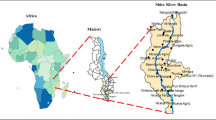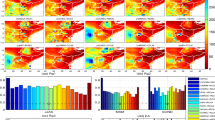Abstract
Prior to hydrological assessment of climate change at catchment scale, an applied methodology is necessary to evaluate the performance of climate models available for a given catchment. This study presents a grid-based performance evaluation approach as well as an intercomparison framework to evaluate the uncertainty of climate models for rainfall reproduction. For this purpose, we used outputs of two general circulation models (GCMs), namely ECHAM5 and CCSM3, downscaled by a regional climate model (RCM), namely RegCM3, over ten small to mid-size catchments in Rize Province, Turkey. To this end, five rainfall-borne climatic statistics are computed from the outputs of ECHAM5-RegCM3 and CCSM3-RegCM3 combinations in order to compare with those of observations in the province for the reference period 1961–1990. Performance of each combination is tested by means of scatter diagram, bias, mean absolute bias, root mean squared error, and model performance index (MPI) measures. Our results indicated that ECHAM5-RegCM3 overestimates the total monthly rainfall observations whereas CCSM3-RegCM3 tends to underestimate. In terms of maximum monthly and annual maximum rainfall reproduction, ECHAM5-RegCM3 shows higher performance than CCSM3-RegCM3, particularly in the coastland areas. In contrast, CCSM3-RegCM3 outperforms ECHAM5-RegCM3 in reproducing the number of rainy days, especially in the inland areas. The results also revealed that if a GCM-RCM combination performs well for a portion (statistic) of a catchment, it is not necessarily appropriate for the other portions (statistics). Moreover, the MPI measure demonstrated the superiority of ECHAM5-RegCM3 to CCSM3-RegCM3 up to 33 % excelling for annual rainfall reproduction in Rize Province.








Similar content being viewed by others
References
Anandhi A, Nanjundiah RS (2015) Performance evaluation of AR4 climate models in simulating daily precipitation over the Indian region using skill scores. Theor Appl Climatol 119:551–566
Barfus K, Bernhofer C (2014) Assessment of GCM performances for the Arabian Peninsula, Brazil, and Ukraine and indications of regional climate change. Environ Earth Sci. doi:10.1007/s12665-014-3147-3
Bastola S, Murphy C, Sweeney J (2011) The role of hydrological modelling uncertainties in climate change impact assessments of Irish river catchments. Adv Water Resour 34(5):562–576
Bozkurt D, Sen OL (2013) Climate change impacts in the Euphrates–Tigris Basin based on different model and scenario simulations. J Hydrol 480:149–161
Bozkurt D, Turuncoglu U, Sen OL, Onol B, Dalfes HN (2012) Downscaled simulations of the ECHAM5, CCSM3 and HadCM3 global models for the eastern Mediterranean-Black Sea region: evaluation of the reference period. Clim Dyn 39:207–225
Collins WD, Bitz CM, Blackmon ML, et al. (2006) The Community Climate System Model Version 3 (CCSM3). J Clim 19:2122–2143
Danandeh Mehr A, Kahya E, Olyaie E (2013) Streamflow prediction using linear genetic programming in comparison with a neuro-wavelet technique. J Hydrol 505:240–249
Deidda R, Marrocu M, Caroletti G, et al. (2013) Regional climate models’ performance in representing precipitation and temperature over selected Mediterranean areas. Hydrol Earth Syst Sci 17:5041–5059
Demirel MC, Moradkhani H (2015) Assessing the impact of CMIP5 climate multi-modeling on estimating the precipitation seasonality and timing. Clim Chang. doi:10.1007/s10584-015-1559-z
Demirel MC, Booij MJ, Hoekstra AY (2013) Impacts of climate change on the seasonality of low flows in 134 catchments in the river Rhine basin using an ensemble of bias-corrected regional climate simulations. Hydrol Earth Syst Sci 7(10):4241–4257
Eris E, Agiralioglu N (2009) Effect of coastline configuration on precipitation distribution in coastal zones. Hydrol Process 23(25):3610–3618
Errasti I, Ezcurra A, Sáenz J, Ibarra-Berastegi G (2011) Validation of IPCC AR4 models over the Iberian Peninsula. Theor Appl Climatol 103(1–2):61–79
Foley AM (2010) Uncertainty in regional climate modelling: A review. Prog Phys Geogr 34(5):647–670
Fu G, Liu Z, Charles SP, Xu Z, Yao Z (2013) A score-based method for assessing the performance of GCMs: a case study of south-eastern Australia. J Geophys Res - Atmos 118:4154–4167
Graham LP, Andréasson J, Carlsson B (2007a) Assessing climate change impacts on hydrology from an ensemble of regional climate models, model scales and linking methods—a case study on the Lule River basin. Clim Chang 81:293–307
Graham LP, Hagemann S, Jaun S, Beniston M (2007b) On interpreting hydrological change from regional climate models. Clim Chang 81:97–122
Grossi G, Caronna P, Ranzi R (2013) Hydrologic vulnerability to climate change of the Mandrone glacier (Adamello-Presanella group, Italian Alps). Adv Water Resour 55:190–203
Halmstad A, Najafi MR, Moradkhani H (2013) Analysis of precipitation extremes with the assessment of regional climate models over the Willamette River Basin, USA. Hydrol Process 27:2579–2590
Harvey LDD, Wigley TML (2003) Charactering and comparing control-run variability of eight coupled AOGCMs and of observations part 1: temperature. Clim Dyn 21:619–646
Hofstadter R, Bidegain M (1997) Performance of general circulation models in south-eastern South America. Clim Res 9:101–110
IPCC (2007) Intergovernmental Panel on Climate Change fourth assessment report on scientific aspects of climate change for researchers, students, and policymakers.
Jacob D, Bärring L, Christensen OB, et al. (2007) An inter-comparison of regional climate models for Europe: model performance in present-day climate. Clim Chang 81:31–52
Jones PD, Reid PA (2001) Assessing future changes in extreme precipitation over Britain using regional climate model integrations. Int J Climatol 21:1337–1356
Kitanidis PK (1997) Introduction to geostatistics: applications to hydrogeology. Cambridge University Press, 249 pp.
Kjellström E, Boberg F, Castro M, Christensen HJ, Nikulin G, Sánchez E (2010) Daily and monthly temperature and precipitation statistics as performance indicators for regional climate models. Clim Res 44:135–150
Kundzewicz ZW, Kanae S, Seneviratne SI, et al. (2013) Flood risk and climate change: global and regional perspectives. Hydrol Sci J 59(1):1–28
Kundzewicz ZW, Mata LJ, Arnell NW, et al. (2008) The implications of projected climate change for freshwater resources and their management. Hydrol Sci J 53(1):3–10
Liu Z, Mehran A, Phillips TJ, AghaKouchak A (2014) Seasonal and regional biases in CMIP5 precipitation simulations. Clim Res 60:35–50
Maxino CC, Mc Avaney BJ, Pitman AJ, Perkins SE (2008) Ranking the AR4 climate models over the Murray-Darling Basin using simulated maximum temperature, minimum temperature and precipitation. Int J Climatol 28:1097–1112
Mondal A, Mujumdar PP (2012) On the basin-scale detection and attribution of human-induced climate change in monsoon precipitation and streamflow. Water Resour Res 48:W10520. doi:10.1029/2011WR011468
Moradkhani H, Baird RG, Wherry S (2010) Impact of climate change on floodplain mapping and hydrologic ecotones. J Hydrol (Amsterdam) 395:264–278
Najafi MR, Moradkhani H, Piechota TC (2011a) Statistical downscaling of precipitation using machine learning with optimal predictor selection. J Hydrol Eng 16(8):650–664
Najafi MR, Moradkhani H, Piechota TC (2011b) Ensemble streamflow prediction: climate signal weighting vs. climate forecast system reanalysis. J Hydrol 442-443:105–116
Nieto S, Rodríguez-Puebla C (2006) Comparison of precipitation from observed data and general circulation models over the Iberian Peninsula. J Climate 19(17):4254–-4275
Önol B, Semazzi FHM (2009) Regionalization of climate change simulations over Eastern Mediterranean. J Clim 22(8):1944–1961
Önol B, Bozkurt D, Turuncoglu UU, et al. (2014) Evaluation of the twenty-first century RCM simulations driven by multiple GCMs over the Eastern Mediterranean–Black Sea region. Clim Dyn 42:1949–1965
Özdoğan M (2011) Climate change impacts on snow water availability in the Euphrates–Tigris basin. Hydrol Earth Syst Sci 15:2789–2803
Ozkul S (2009) Assessment of climate change effects in Aegean river basins: the case of Gediz and Buyuk Menderes Basins. Clim Change 97:253–283
Pal JS, Giorgi F, Bi X, et al. (2007) Regional climate modeling for the developing world: the ICTP RegCM3 and RegCNET. Bull Am Meteorol Soc 88(9):1395–1409
Perkins SE, Pitman AJ, Holbrook NJ, McAneney J (2007) Evaluation of the AR4 climate models’ simulated daily maximum temperature, minimum temperature, and precipitation over Australia using probability density functions. J Clim 20:4356–4376
Reichler T, Kim J (2008) How well do coupled models simulate today’s climate. Bull Am Meteorol Soc 89:303–311
Roeckner E, Bäuml G, Bonaventura L, et al. (2003) The atmospheric general circulation model ECHAM5. Part I: model description. Max Planck Inst Meteorol Rep 349:127
Roosmalen LV, Christensen JH, Butts MB, et al. (2010) An intercomparison of regional climate model data for hydrological impact studies in Denmark. J Hydrol 380:406–419
Şen ÖL (2013) A holistic view of climate change and its impacts in Turkey. Report. Istanbul Policy Centre, Sabanci University, Istanbul
Shen Y, Oki T, Kanae S, et al. (2014) Projection of future world water resources under SRES scenarios: an integrated assessment. Hydrol Sci J 59(10):1775–1793
Smith I, Chandler E (2010) Refining rainfall projections for the Murray Darling Basin of south-east Australia—the effect of sampling model results based on performance. Clim Chang 102:377–393
Van Der Linden P, Mitchell JFB (Eds) (2009) ENSEMBLES: climate change and its impacts: summary of research and results from the ENSEMBLES Project. Met Office Hadley Centre, Fitz Roy Road, Exeter EX1 3 PB, UK, 160.
Van Vliet MTH, Blenkinsop S, Burton A, et al. (2012) A multi-model ensemble of downscaled spatial climate change scenarios for the Dommel catchment, Western Europe. Clim Chang 111:249–277
Varis O, Kajander T, Lemmelä R (2004) Climate and water: from climate models to water resources management and vice versa. Clim Chang 66:321–344
Vaze J, Teng J, Chiew FHS (2011) Assessment of GCM simulations of annual and seasonal rainfall and daily rainfall distribution across south-east Australia. Hydrol Process. doi:10.1002/hyp.7916
Xuejie G, Zongci Z, Giorgi F (2002) Changes of extreme events in regional climate simulations over East Asia. Adv Atmos Sci 19(5):927–942
Acknowledgments
This work is part of a research project supported by the Scientific and Technological Research Council of Turkey (TUBITAK) under Grant Number 112Y214. The authors thank the project research team: D. Z. Şeker, M. Özger, D. Bozkurt, O. Şen, and H. Erdem for their contribution in the study.
Author information
Authors and Affiliations
Corresponding author
Rights and permissions
About this article
Cite this article
Danandeh Mehr, A., Kahya, E. Grid-based performance evaluation of GCM-RCM combinations for rainfall reproduction. Theor Appl Climatol 129, 47–57 (2017). https://doi.org/10.1007/s00704-016-1758-1
Received:
Accepted:
Published:
Issue Date:
DOI: https://doi.org/10.1007/s00704-016-1758-1




